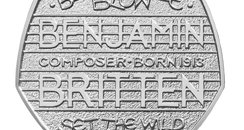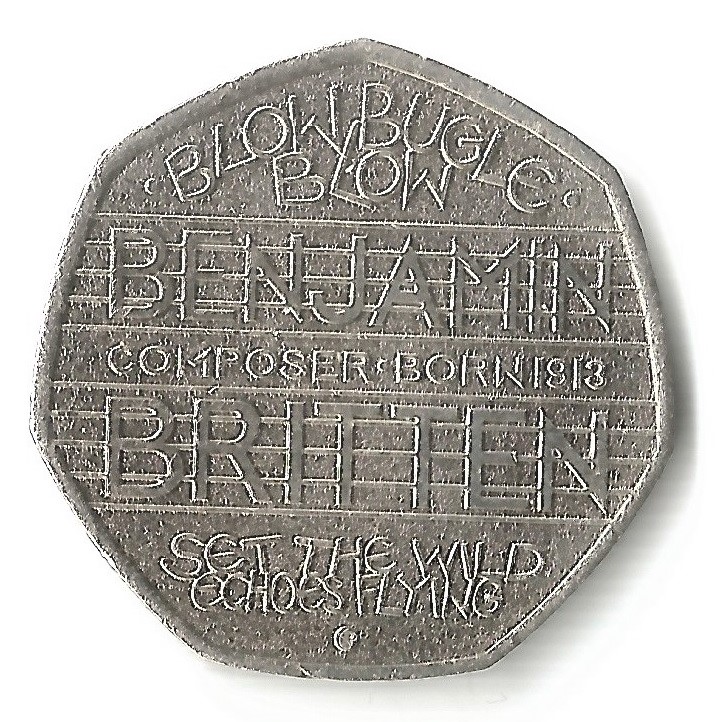Benjamin Britten 50p
- Benjamin Britten 50p 2017
- Benjamin Britten Composer
- Benjamin Britten 50p
- Benjamin Britten 50p Value
- Benjamin Britten Songs
A Benjamin Britten 50p coin in good circulated condition (A few small contact marks on the coin, but retains some original shine and most of the original design detail.) will be worth more than a worn down battered coin. Prices shown on this page relate to coins created for circulation. Fifty (50p) coins issued by Royal Mint, UK in various design from 1969 till date (2016). The 100th Anniversary of the Birth of Benjamin Britten (2013) 21. Since his death in 1976, Britten's reputation as one of the greatest musicians of the age has continued to grow. This 50p design has been issued to commemorate the centenary of his birth in 1913, and features celebratory words from Tennyson set against a double stave - referencing the piano on which Britten was a. Exploring the Benjamin Britten 50P Coin Composer, conductor, and pianist Benjamin Britten was so renowned that he was honoured by having his visage on a 50 pence coin in 2013. There are several things that make this coin notable, including the fact that it is the first 50p coin to show the date and denomination on the obverse, so it can be a.
Using our Change Checker stats we have recently embarked on some number crunching to gain an accurate idea of collecting patterns – here we reveal which coins are the most requested by users.
The results may surprise you..
Olympic 50p

1. Judo
2. Football
3. Triathlon
Of the 29 Olympic 50ps which are still proving immensely popular with collectors, the most sought-after coin is Judo, closely followed by the highly publicised football 50p which explains the offside rule through a simple diagram. The triathlon design takes the bronze medal in third place.
£2
Benjamin Britten 50p 2017
1. London Underground (Roundel)
2. Charles Dickens
3. London 2012 Handover to Rio
The London Underground £2 series was released at the start of the year to celebrate the 150th anniversary of the tube, and it is the iconic Roundel logo design which tops the table of most requested in the £2 category.
Not far behind is the innovative Charles Dickens £2 which was issued last year and features the author’s famous profile crafted from the titles of his most famous works. The London 2012 Handover to Rio £2 marking last year’s Olympic handover ceremony makes up the top three in the category.
50p
1. WWF
2. Girl Guides
3. UK Entry to EEC
One coin which has seemed to unite favourable public opinion is the WWF 50p issued in 2011. The design by Matthew Dent features 50 individual icons which represent the various facets of the WWF with the famous Panda at the heart of it.
The design tops the most requested by Change Checkers in the 50p category, closely followed by the Girl Guides. The UK’s entry to EEC was the first commemorative design of the newly sized 50ps, and this is currently the third most requested.
£1
1. London
2. Belfast
3. Cardiff
£1 coins often go unnoticed as commemorative issues, but there are four different series of £1 designs which have been in circulation for nearly 30 years. They all carry the same concept of representing each of the four constituent countries in the UK through various themes.
There was an obvious trend in the Change Checker results with the Capital Cities series making up the entire top 3 with London the most requested, followed by Belfast and Cardiff.
Have you got any of these coins available to swap? Maybe even all four in our wanted poster? If so you’ll be a very popular person in the Change Checker Swap Centre.
Outstanding composer, virtuoso pianist, talented conductor, inspired recording artist, major music festival organiser, peerless arranger of folksongs – there was seemingly nothing he didn’t excel at. Yet not everyone was equally impressed by Benjamin Britten.
Britten was one of the most outstanding English musicians of the 20th century. In addition to his prodigious achievements as a composer, he was a stunningly gifted pianist, accompanist, conductor and arranger.
He was also a natural recording artist, as is testified by definitive accounts of his own music for Decca, as well as landmark recordings of masterpieces by Bach, Purcell, Mozart and Schumann. Yet despite his extraordinary fluency and emotional directness, Britten’s music was considered “difficult” in parochial circles, even by those prepared to go along with some of the thornier masterpieces of Vaughan Williams and Walton.
Britten was also happiest when writing choral music, songs and operas at a time when English musical opinion was polarised by an all-consuming passion for such “elevated” instrumental forms as the symphony, string quartet and piano sonata.
If Britten’s unconventional concentration on vocal music did little to endear him to the establishment, his lifelong companionship with the great English tenor, Peter Pears, encapsulated his homosexual leanings at a time when such things were best not talked about.
Always highly sensitive to criticism, Britten effectively cut himself off from the musical mainstream by setting up shop at Aldeburgh, near the Suffolk coast. Here he enjoyed the company of a small but distinguished circle of friends, which unfortunately had the effect once again of making even those who were essentially sympathetic to his music feel like outsiders.
Born into a reasonably prosperous Lowestoft family, by the age of 14 Britten was already advanced enough to merit lessons with Frank Bridge, who was to remain the single most profound creative influence on the budding young composer.
“In everything he did for me,” Britten fondly recollected, “there were perhaps above all two cardinal principles. One was that you should try to find yourself and be true to what you found. The other was his scrupulous attention to good technique, the business of saying clearly what was in one’s mind.”
Following a successful scholarship interview at the Royal College of Music – after which one of the examiners privately exclaimed: “What is an English public schoolboy doing writing music of this kind?” – Britten’s studies with the traditionalist John Ireland were less than happy.
Benjamin Britten Composer
However, the young genius continued to pour forth blindingly original music, including a series of piano pieces that would later form the basis for his popular Simple Symphony (1933-4).
During his years at the RCM, Britten became absorbed in contemporary music, and even suggested that the College might like to place a copy of the score of Schoenberg’s radical Pierrot Lunaire in the library – they refused. Britten even won a scholarship to study with Schoenberg’s disciple Alban Berg in Vienna, although his mother was against the idea.
Nevertheless, Britten continued to progress at a phenomenal rate. Upon leaving the College he was invited to compose the incidental music for a series of documentaries, climaxing in the memorable Coal Face and Night Mail.
It was through these that he first met the celebrated writer WH Auden, with whom he would soon collaborate on his first opera, Paul Bunyan. He was also signed up by the publishers Boosey & Hawkes, and at the age of 24 composed his astonishingly assured Variations On A Theme Of Frank Bridge, a blistering masterpiece that announced the arrival of a major new force in British music.
An instinctive pacifist, Britten spent the early part of World War II in America, where his friendship with Pears blossomed. His most outstanding work of this period was the Sinfonia Da Requiem, a stunning indictment of man’s inhumanity to man.
Turning the coin over, during the return journey to England in 1942 Britten composed the glorious Hymn To St Cecilia and Ceremony Of Carols. The latter is one of his most innocent and uncomplicated scores, remarkable for a man living under the threat of a U-boat attack.
Britten recorded the Ceremony Of Carols the following year and sales surpassed all expectations. This established him as a serious recording artist. Meanwhile, Britten was exempted from military service as a conscientious objector.
Whatever his achievements during his American sojourn, the most important event, which was to prove central to the remainder of Britten’s creative life, was the conductor Serge Koussevitzky’s suggestion that he compose a full-scale opera.
The eventual result was a barnstorming, post-Romantic masterpiece: Peter Grimes – a work of such astonishing maturity and power that it is easy to overlook the fact that Britten was only 31. The parallels between the central figure, a rough-and-ready Suffolk fisherman vilified by an uncomprehending society when his apprentice is lost at sea, and Britten’s view of his own artistic station in life are hard to ignore.
Two contrasted chamber operas of a very different hue followed Grimes in quick succession – The Rape Of Lucretia and Albert Herring – in the wake of which Britten set up the English Opera Group in 1947 and founded the annual Aldeburgh Festival the following year.
Aldeburgh was to become Britten’s spiritual home, and much of the music he subsequently composed was specifically written to be performed there by friends and colleagues under his direction and/or accompaniment.

Fired by the success of Peter Grimes, Britten was now at the height of his powers. Two choral classics, composed virtually back to back, won considerable popularity – St Nicholas (1948) and the Spring Symphony (1949) – and during the early 1950s Britten went into creative overdrive with what are arguably his two greatest masterpieces, both of them operas – Billy Budd (1951) and The Turn Of The Screw (1954).
Benjamin Britten 50p
The latter is a chilling adaptation of the Henry James ghost story. Using only a chamber group and setting the opera against the background of an awesomely inventive set of variations – you can feel the atmosphere tightening with each “turn of the screw” – this claustrophobically intimidating work never lets go.
Benjamin Britten 50p Value
The moment the boy Miles cries out, “Peter Quint, you Devil”, releasing him from the maliciously ghoulish attentions of his “possessor”, is one of music’s great heart-stoppers.

Benjamin Britten Songs
Britten’s next major opera, A Midsummer Night’s Dream (1960), signalled a return to the richness and emotional directness of his pre-Grimes music, reaching a climax in the War Requiem of 1962.
This is based partly on the traditional Requiem Mass, and partly on the poems of Wilfred Owen. The premiere in Sir Basil Spence’s newly restored Coventry cathedral on 30 May 1962, was accorded what was then the rare honour of a “live” outside broadcast by the BBC, and Britten’s classic recording sold a staggering 200,000 copies in six months.
Following the War Requiem, Britten moved progressively towards more intimate forms of expression, which showed an often disturbing predilection for the dark side of human nature, including the three church parables – Curlew River (1964), The Burning Fiery Furnace (1966) and The Prodigal Son (1968).
His final operatic utterance was the unbearably poignant Death In Venice (1973), while his last completed work, Phaedre, premiered only six months before his death in December 1976, takes us over into the abyss and beyond.
Whatever his musical achievements, Britten above all wanted to feel useful, to be a vital part of everyday society.
This bubbles over in a 1964 newspaper article, which reads like his musical epitaph: “The ideal conditions for an artist or musician will never be found outside the ideal society, and when shall we see that? But I think I can tell you some of the things that any artist demands from any society. He demands that his art shall be accepted as an essential part of human activity and human expression; and that he shall be accepted as a genuine practitioner of that art and consequently of value to the community.”